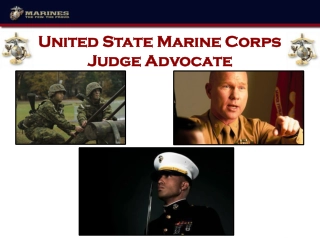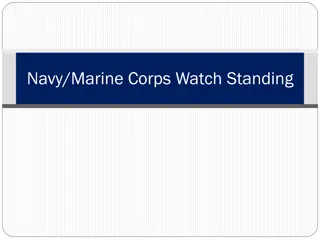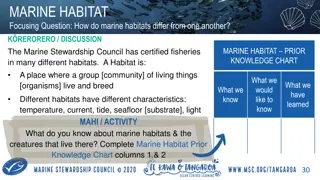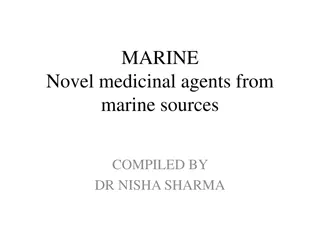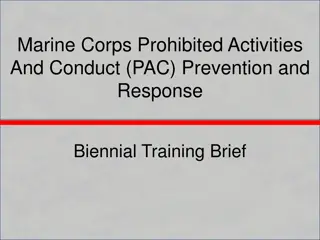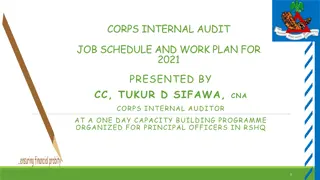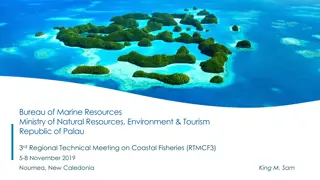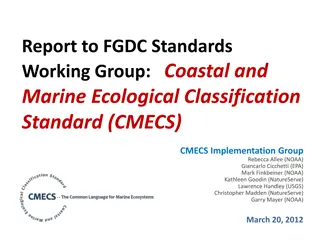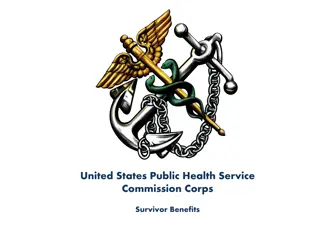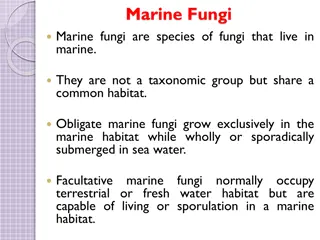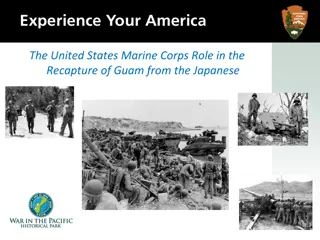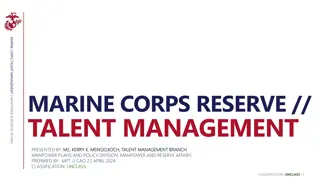Marine Corps Planning and Priorities Overview
Marine Corps Commandants are focused on force design, warfighting education, leadership, and naval integration. They aim to maintain high standards, remove mediocrity, care for Marines, and prioritize future force development. The Corps is trained for naval expeditionary missions and crisis response, emphasizing readiness, containment, and combat if necessary.
Download Presentation

Please find below an Image/Link to download the presentation.
The content on the website is provided AS IS for your information and personal use only. It may not be sold, licensed, or shared on other websites without obtaining consent from the author. Download presentation by click this link. If you encounter any issues during the download, it is possible that the publisher has removed the file from their server.
E N D
Presentation Transcript
References 38th Commandant s Planning Guidance
CMCs Planning Guidance The Marine Corps will be trained and equipped as a naval expeditionary force-in-readiness and prepared to operate inside actively contested maritime spaces in support of fleet operations. In crisis prevention and crisis response, the Fleet Marine Force acting as an extension of the Fleet will be first on the scene, first to help, first to contain a brewing crisis, and first to fight if required to do so.
Priority Focus Areas Force Design Warfighting Education and Training Core Values Command and Leadership
FD2030 Force design is my number one priority. I have already initiated, and am personally leading, a future force design effort. Going forward, CD&I will be the only organization authorized to publish force development guidance on my behalf. We will divest of legacy defense programs and force structure that support legacy capabilities. If provided the opportunity to secure additional modernization dollars in exchange for force structure, I am prepared to do so .
Naval Integration Marine Corps integration into the Fleet via composite warfare will be a prerequisite to the successful execution of amphibious operations: Marines cannot be passive passengers en route to the amphibious objective area.
Taking Care of Marines Taking care of Marines includes holding Marines to high professional standards of performance, conduct, and discipline. Leaders are expected to do everything within their power to ensure the individual Marine succeeds, but there are limits to our abilities to sustain the transformation of the individuals who simply choose to opt out. Marines failing to adhere to our standards or failing to remain competitive within their occupational fields or grade will be separated. Demanding superior performance and enforcing high standards should not be viewed as draconian, but rather, should be expected by professionals. We will not accept mediocrity within the force and, above all, must seek to remove those from within our ranks who are adversely impacting the overall readiness of our force.
Basic Officer Course Mission: Train and educate newly commissioned or appointed officers in the high standards of professional knowledge, esprit-de-corps, and leadership to prepare them for duty as company grade officers in the operating forces, with particular emphasis on the duties, responsibilities, and warfighting skills required of a rifle platoon commander.
5 Horizontal Themes A Marine Officers is: A man or woman of exemplary character. Devoted to leading Marines 24/7. Able to decide, communicate, and act in the fog of war. A Warfighter who embraces the Corps warrior ethos. Mentally strong and physically tough.
Course Structure Phase I: Individual Skills Leadership Rifle and Pistol Qualification Land Navigation Communications Combat Lifesaving MCMAP Phase III: Rifle Platoon Commander Skills Rifle Platoon Tactics Convoy Operations Engineering Crew-served weapons Phase IV: Basic MAGTF Officer Skills Military Operations in urban Terrain (MOUT) Rifle Platoon (REIN) Tactics Force Protection Expeditionary Operations Legal/Platoon Commander s Administration Phase II: Rifle Squad Leaders Skills Decision-making Combined Arms Rifle Squad Tactics/Weapons Scouting and Patrolling
Quality Spread In 1977, the Commandant of the Marine Corps (CMC) made the decision to apply a quality spread to the assignment of MOSs. This decision was made to ensure every OccFld received a fair share of the most competitive lieutenants. This policy remains in effect today as MOS assignments at TBS are made by balancing four factors: MOS quality distribution; student suitability; unique or additional considerations; and student preferences, in order of priority. Quality distribution has proven to be the most effective way to serve the needs of the Marine Corps while considering the desires of the students. In addition to quality distribution across the thirds, all decisions on MOS assignment are made with consideration of student suitability, unique or additional considerations, and student preferences.
Marine Littoral Regiment MAGTF with four elements: Command Element Littoral Combat Team (LCT) - GCE Littoral Anti-Air Battalion (LAAB) - ACE Littoral Logistics Battalion (LLB) - LCE



